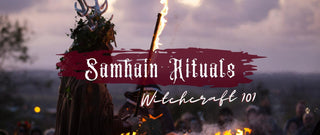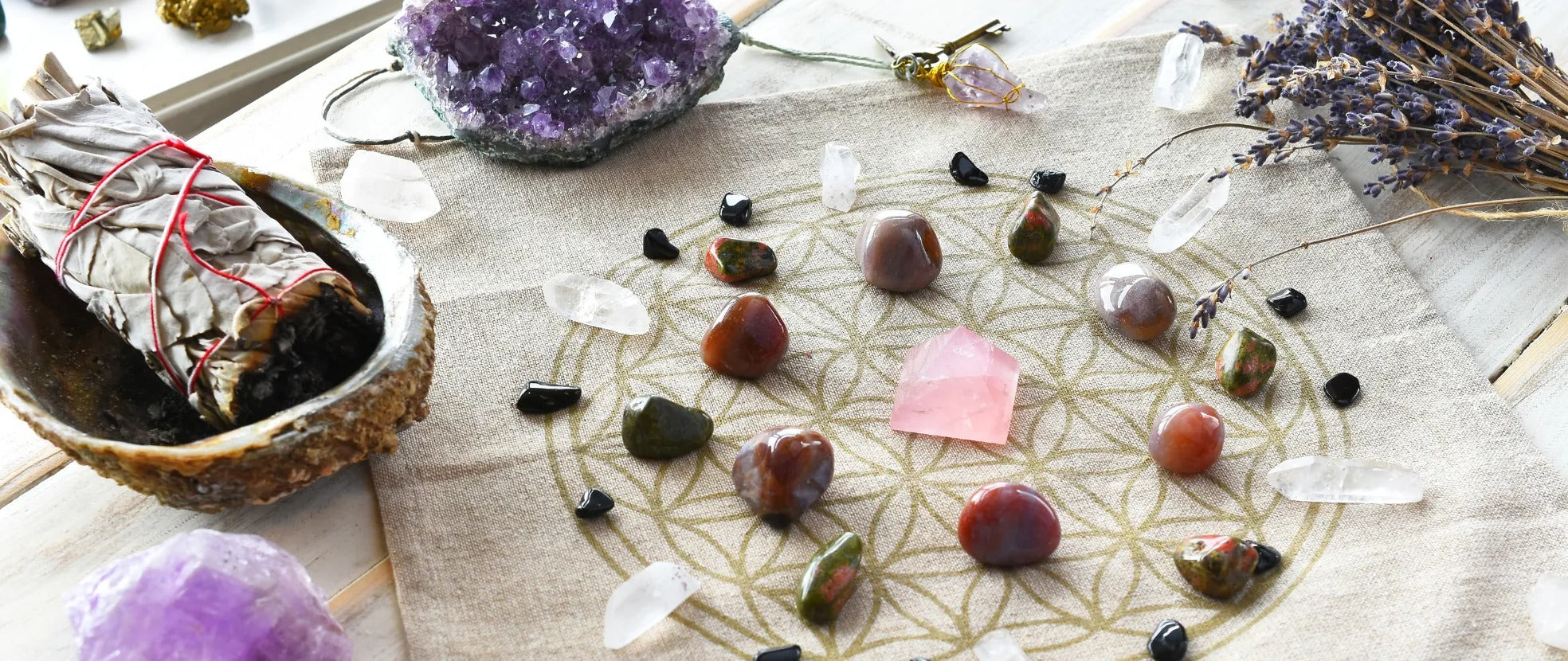Samhain (a Gaelic word pronounced as SAH-ween) is a Pagan religious festival that is celebrated from late October to early November. Witches, Wiccans, Druids, and other Pagan religions around the world observe Samhain to mark the end of the harvest season and welcome the coldest time of the year.
Samhain is celebrated on October 31st.
But samhain is more than just a periodic turn of seasons. To Pagans, it is a spiritual new year; the time to let go of old ways and unlearn habits. It's also the perfect time to reflect on the natural cycle of life, death, and rebirth.
Celebrants believe that during Samhain, the barrier that separates the physical and spiritual realm breaks down. So besides remembering and paying respects to their loved ones who passed, Pagans take this time to invoke blessing, guidance, and protection from their ancestors.
Read on to learn more about the Samhain festival according to Selena Fox, senior minister of the Circle Sanctuary (a Wiccan church and Pagan resource center). And if you're into witchcraft, this post will teach you what rituals to perform to make the most of the celebration.

Samhain's History in a Nutshell
Where does the name Samhain come from?
Folks on the internet claim that Samhain was derived from the name of some ancient Celtic god of death. However, according to religious scholars, Samhain comes from the Gaelic (a Celtic language spoken in some parts of western Scotland) word samhuin, meaning the end or beginning of summer. This refers to the end of the summer season on earth and the beginning of the cold and dark times in the Underworld, which is technically the daylight hours of November 1st.
Samhain and Halloween: What's the Difference?
Halloween (short for All Hallow's Eve) and Samhain are celebrated on and around October 31. While they occur at the same time of the year and celebrate the end-of-harvest, Halloween and Samhain differ in focus and practice.
Halloween is a secular holiday like Thanksgiving and is celebrated by kids, their families, and many other communities across different cultures, traditions, ethnic backgrounds, religions, and worldviews.
Over the years, Halloween has also morphed into a children's holiday as well as a social gathering where people of all ages can express themselves creatively by wearing costumes, storytelling, trick-or-treating, visiting scary places, and throwing parties.
But for modern Pagans, Samhain, in contrast, is more religious in scope. Since the beginning, it's a Sabbat that pays homage to the ancestors who came before them and marks the dark times of the year.
While it also involves merry-making, honoring the dead is the main focus of Samhain, and light-hearted festivities are only secondary to this.
When should I perform my Samhain rituals?
Pagans in the northern hemisphere often celebrate Samhain from the sundown of October 31 until the daylight of November 1. Others celebrate on the New Moon or Full moon closest to these dates. Some celebrants time their Samhain rituals near November 6 which is nearer to the midpoint between the Fall Equinox and Winter solstice.
Meanwhile, Pagans from the southern hemisphere observe Samhain during the middle of their Autumn around late April and early May instead of during the European time of the holiday.
Adherents of Samhain perform rituals either in private or public. Samhain can be celebrated over several days and nights. These are held with a string of solo rites or including feasts, ceremonies, and intimate gatherings with family, friends, and spiritual communities. The timing and how this celebration is held varies depending on tradition and geographical location.

How to Take Part in the Samhain Celebration
There are many rituals you can perform to celebrate Samhain. Below are some ideas for starters:
1. Samhain Nature Walk
Samhain is a great time to be one with nature and to ground yourself to the Earth's energy. Do this by taking a meditative walk by the park near your home or outdoors. Look around and take in the colours, sounds, aromas, and other sensations you could perceive.
Reflect on your role as a living being who's part of Nature. Reflect on the Cycle of Life and on death and rebirth. Collect some objects from nature that remind you of life and death. Use these items to adorn your home (or put them on your altar).
2. Create a Samhain Altar
New to the Pagan tradition and don't have your sacred space yet? Setting up your own altar is easy. You can do this three days before Samhain.
An altar serves as the centerpiece of your ritual and worship. It's the one spot in your home that holds all the objects and symbols that remind you of your beliefs. Decorate your altar with the following items symbolic of late fall:
- Dried leaves and acorns
- Harvest food like squash, pumpkins, and root vegetables
- Berries, nuts, and dark breads
- A cornucopia containing various fruits and vegetables
- Mulled cider, mead, or wine
- Skulls, skeletons, and grave rubbings
You can put anything on your altar as long as it represents your belief and it reminds you of life, death, and rebirth.
READ: How to Set Up Your First Altar AKA Your Sacred Space
3. Set Up an Ancestors' Altar
This ceremony aims to honour your deceased loved ones. You can make your ancestors altar just for the Samhain celebration or keep it all year round.
- Gather some photos, heirlooms, keepsakes, and other mementos of your late family members, friends, or even pets.
- Place them on a table, dresser, or other flat surface. Then light several votive candles in their memory.
- While lighting the candles, say their names out loud. Thank them for playing a role in your life and being part of your lineage.
- Send well wishes their way.
- Sit quietly and enter into a meditative state. Pay attention to what you experience.
- Write down any messages you receive in your journal.
4. Visit a Cemetery
Carve some time out to visit your late loved ones at the cemetery and tend to their gravesite. Together with your family or friends, reminisce your fond memories of them. Count the ways your loved one remains to live on within you even after their passing. Offer them fresh flowers and some fresh water. Light some candles for them.
5. Feast of the Dead
Prepare a Samhain dinner. When setting your table, include a place setting for the Dead. Add a little serving of each beverage being consumed to the cup and a little serving of each dish to the plate.
Invite your ancestors and other deceased loved ones to dine with you and partake of the feast. (You can also have this as a dumb supper and dine in silence to make this ritual as solemn as possible.)
Once done, place the contents of the plate and cup for the Dead outdoors as an offering.
6. Seek Divine Guidance
Since Samhain is a time for renewal and transformation, ask guidance from the Divine as you go into a new year. Use tarot cards, scrying, runes, or other divination methods and rituals you're familiar with. Then write a summary of your processes and the messages you received in your journal.
READ: Get Over Your Ex, Attract Wealth, Set New Goals with These 3 Powerful Rituals
7. Slow Down, Assess Your Life
Remember that Samhain is a celebration of life in contrast to death, so it's an opportunity to take an honest look at your life and introspect. Reflect on your life. Revisit your old journals, planners, the photos you took, and the blogs you’ve written. See how you've grown.
Check on your accomplishments, the challenges you've hurdled, the adventures you took”all of it. Journal about your observations and reflections.
8. Know More About Your Ancestors
Brush up on the nitty gritty of your family history. Ask your older relatives to share the life story of your late family members (e.g., where your great grandparents come from, where they settled, the challenges they faced, etc.).
Record these stories in writing (or other means) and share what you learned with other family members. Add new names that come up while learning your family history to your ancestors' altar and honour them.
9. Set Intentions to a Bonfire
Kindle a bonfire outdoors or light up a fireplace or a cauldron. On a piece of paper, write down a habit you want to end and cast it into the flames. This act is a symbolic declaration of releasing habits that don’t serve your growth and purpose.
As you do this, walk around the fire clockwise. Open your mind and heart to more productive habits and lifestyle.
10. Connect with Your Community
Samhain is also a great time to nurture your bonds with others outside of your family. Join a group ritual in your area. End the ceremony with a Samhan potluck at your home. Talk to others and exchange ideas, rituals, and experiences. Read up, watch videos, or ask others about contemporary Samhain customs and traditions.
Whether you observe Samhain alone or with others, it's always good to stay connected to a network of believers who are one with you in celebrating Samhain.
Sources:
The Alternative Halloween Celebration: 13 Rituals to Celebrate Samhain. (n.d.). Gaia. Retrieved October 20, 2022, from https://www.gaia.com/article/modern-paganism-13-rituals-celebrate-samhain
Blumberg, A. (2016, October 28). Samhain 2016: Traditions And Rituals For The Pagan New Year. HuffPost. Retrieved October 20, 2022, from https://www.huffpost.com/entry/samhain-2016-traditions_n_5813717be4b064e1b4b1eff6
Celebrating Samhain. (n.d.). Circle Sanctuary. Retrieved October 20, 2022, from https://www.circlesanctuary.org/index.php/celebrating-the-seasons/celebrating-samhain
A Feast With the Dead: How to Hold a Pagan Dumb Supper for Samhain. (2018, February 20). Learn Religions. Retrieved October 20, 2022, from https://www.learnreligions.com/feast-with-the-dead-2562707
The History of the Pagan Samhain Sabbat. (2019, April 27). Learn Religions. Retrieved October 20, 2022, from https://www.learnreligions.com/about-samhain-history-2562713
History.com Editors. (2022, October 5). Samhain. HISTORY. Retrieved October 20, 2022, from https://www.history.com/topics/holidays/samhain





